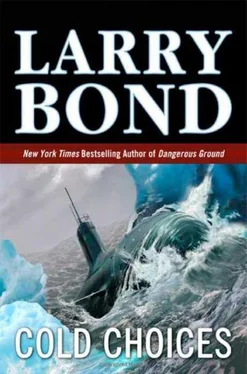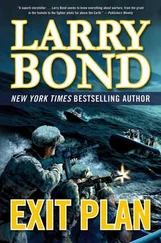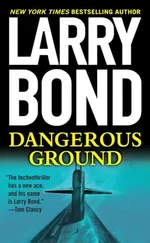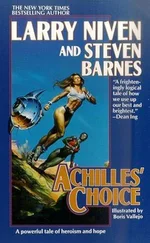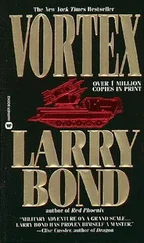So Harry Brewer, INN news producer, had flown from the U.S. to Norway. Heading north from Oslo in a chartered plane, he and his crew had found Jonson and his men on the northern coast, in the fishing town of Alesund.
Stavanger was a sturdy-looking craft, not big, but big enough for Brewer, his assistant, a cameraman and a soundman. Jonson’s crew of five spoke at least passable English, and the cook had proven to be very good, although Brewer was getting a little tired of fish.
There was no question about where to go. The Internet was full of maps and diagrams showing the location of the rescue site. And as for the exclusion zone, Brewer dismissed the prohibition. The only good stories were on the far side of the police tape. Working as a journalist, he’d climbed dozens of fences. Sometimes they shooed him away, sometimes he got the goods. On something like this, with worldwide play, he was ready to do whatever it took. To tell the truth, he’d enjoyed the adrenaline rush when the Russian helicopter had appeared, and watching it disappear had been even sweeter. His cameraman had gotten plenty of footage.
Brewer checked their progress on the chart, although he already knew what it would show. They were on course, on schedule, chugging away at Stavanger’s best speed of twelve knots. Most of Jonson’s repairs had been to her two diesel engines, and now he was running them almost flat out.
It was vital that Stavanger reach the rescue site by dawn tomorrow. Most of the activity would take place in the morning, and he needed daylight to position himself properly. Footage of the Russian rescue capsule would be flashed around the world within minutes of it breaking the surface, and it would be his crew that got it. Definitely Pulitzer Prize material.
A shout in Norwegian pulled him back to the bridge windows. Jonson quickly raised his glasses, and searched to the north. The first mate, manning the helm, translated for Brewer. “The lookout says he can see a helicopter.”
“The same one?” Brewer asked.
The mate shrugged. “It’s coming from the same direction.”
Brewer wanted to borrow the captain’s binoculars, but he wouldn’t know what he was looking at. It only took a few minutes to confirm that the aircraft was approaching them again, but from dead on, they could tell nothing about it.
Finally, it grew from a speck to a shape, and Jonson announced, “It’s not the same kind. I think it’s American.”
“What?” Brewer was surprised at the idea of an American aircraft in these waters. But an American destroyer was part of the rescue group. It could have come from that ship. What did they want?
Jonson maintained course and speed, and the helicopter circled them twice, first from a distance, then closer in, only a few hundred yards away. As it circled, Brewer studied the craft, wondering if this one was armed. Jonson had the same thought, and reported, “No weapons. Those pods on each side are drop tanks.”
Finally, it came up on their port side, only a hundred feet up and not much farther away. The radio came to life. “Norwegian fishing vessel, this is a U.S. Navy helicopter. You are inside a maritime exclusion zone established during a rescue operation. Turn around immediately and head southwest.”
Jonson looked at Brewer who shook his head violently. “Do not answer. As long as we don’t answer, they can’t say we received their transmission. This is just like the other one. It’s unarmed.”
The helicopter repeated its message, and when it didn’t receive a reply, it changed position, dropping aft and closing. Brewer knew they were looking for the vessel’s name on the stern, but he’d had the captain cover it with a fender. He hadn’t been able to talk Jonson into taking down the Norwegian flag.
“Norwegian fishing vessel, you are violating international law. You are approaching an area where rescue operations are underway. If you do not come about, you will be arrested on your return and fined.”
Brewer quickly said, “INN will pay the fines and any other expenses.”
Johnson looked unconvinced. He scratched his blond beard thoughtfully. “What if I lose my license?”
Brewer answered lightly, “If they’re going to arrest us when we go back, let’s go back with the story. INN will be more interested in backing you up if you help us.”
The fisherman looked dubious, but Brewer said, “Look, you’re working for me. I’ll take the heat, and all they ever do to a journalist is kick us out. I’m trying to do my job.”
Jonson looked over at the first mate, who said nothing for a long moment. Finally, he gave a slight nod, and Jonson said, “All right. I will not pay any fines. Your bosses will pay them.”
They pressed on. The helicopter climbed and took station behind the fishing boat; steering large, slow figure eights to stay in position. Every ten minutes the aircraft would call them, but never received a response. Brewer wondered how long the aircraft’s fuel would last.
At sunset, the helicopter was still in position, its navigation lights marking its position long after its shape had blended with the night sky. Brewer knew the helicopter could track them with radar. They’d used radar to find Stavanger in the first place. There was no way to evade detection or slip in. He was just going to call their bluff.
They were having an early dinner when the lookout’s excited call brought Brewer and the captain up to the bridge. The third mate pointed to the radar, mounted in front of the ship’s wheel. “Twenty kilometers,” Jonson commented, “about eleven miles.”
The second mate was standing in the companionway, and Johnson barked orders in Norwegian. The second took the helm, while the third fastened his cold-weather gear and picked up a pair of binoculars.
Jonson studied the scope for a minute, then took a second range reading. “He’s coming fast,” the captain remarked. “About thirty knots.”
“Could it be a commercial ship?” Brewer asked.
Jonson snorted. “In these waters? At this time of year? At that speed? No, mister reporter, that is a warship.” Several emotions quickly played across the captain’s face — frustration, disappointment, then resignation.
Brewer went through a different set of emotions. He would have thought they had more important things to do than chase a harmless fishing boat, but he was ready for them.
The position of the lights didn’t change, but the shape they marked grew steadily larger. With only a quarter moon and a partly cloudy sky, it was virtually invisible, even with Brewer knowing where to look.
Then, at one mile’s distance, the ship suddenly flashed into visibility. They’d turned on their exterior lights. In the pitch darkness it almost floated somewhere between the dark sky and the darker sea.
“Norwegian fishing vessel, this is a U.S. Navy destroyer USS Churchill. Identify yourself.” The voice sounded like a Brit.
Confused, Brewer shook his head again, and half-reached out as Jonson walked toward the radio. The captain ignored him, and instead handed Brewer the glasses, pointing toward the ship as he picked up the microphone.
Brewer looked though the binoculars at the warship. He recognized it as an Aegis destroyer. He’d bought several books in the U.S. and studied them on the flight. It was a gray thing, all angles and shapes. It looked huge, even a mile away.
“This is motor vessel Stavanger, out of Alesund.”
Brewer studied the ship. It was exciting, seeing a warship like this, in its element. He wasn’t worried, even when he saw the gun on the bow pointed in their direction. This was an American ship.
“Stavanger ; what is your business?”
“Tell them we have been chartered by Marine Salvage. We are bringing supplies to Halsfjord,”
Читать дальше
